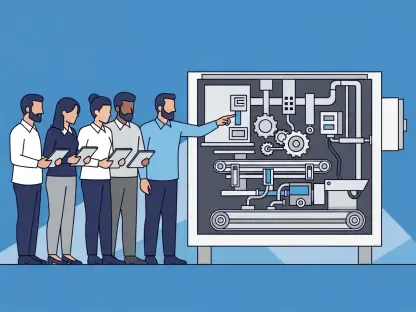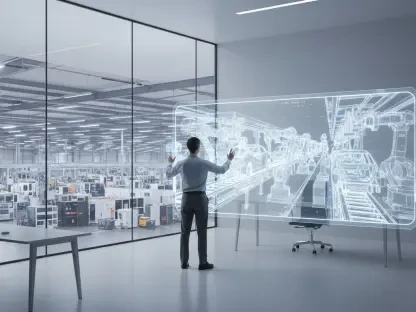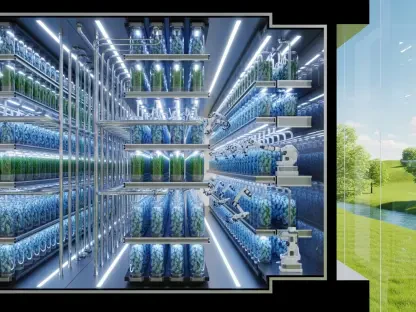In an era marked by rapid technological advancements and interconnected systems, the security of cyber-physical systems (CPS) stands as a critical concern for industries such as manufacturing, energy, and infrastructure, which rely heavily on these technologies. These systems, which integrate physical processes with networked digital devices, are increasingly vulnerable to a complex web of global uncertainties. Economic fluctuations, geopolitical tensions, and supply chain disruptions have emerged as significant catalysts for heightened cybersecurity risks. A recent comprehensive report from a leading CPS protection company sheds light on how these external pressures are creating a challenging landscape for security professionals. With nearly half of surveyed experts pointing to supply chain issues as a major threat, the urgency to adapt and fortify defenses has never been clearer. This discussion delves into the multifaceted challenges facing CPS security and explores the strategies being employed to navigate an unpredictable world.
Economic and Geopolitical Pressures on CPS Environments
The intersection of economic instability and geopolitical unrest has created fertile ground for cyber threats targeting CPS environments. A staggering 49% of security professionals surveyed in a recent industry report identified supply chain disruptions—often fueled by global economic policies and international conflicts—as a primary driver of increased cyber risks. These disruptions can lead to delays in critical updates or patches for CPS assets, leaving systems exposed to potential exploits. Moreover, the cascading effects of such instability often distract organizations from prioritizing cybersecurity, as resources are diverted to address immediate operational challenges. The impact is particularly pronounced in industries reliant on just-in-time manufacturing or global logistics, where even minor interruptions can have outsized consequences. As tensions persist across borders, the risk of state-sponsored cyberattacks targeting critical infrastructure grows, amplifying the need for robust defenses in an already strained environment.
Beyond supply chain concerns, geopolitical dynamics are forcing a reevaluation of operational strategies to mitigate CPS vulnerabilities. Approximately 67% of respondents in the same report indicated they are reassessing the geographic layout of their supply chains to reduce exposure to unstable regions. This shift, while proactive, introduces new complexities, such as identifying reliable partners and ensuring compliance with varying regional cybersecurity standards. Additionally, 45% of professionals expressed uncertainty about their ability to fully understand and mitigate risks to critical CPS assets. This lack of confidence underscores a broader challenge: the unpredictability of global events often outpaces the ability to adapt security measures. As organizations grapple with these external pressures, the potential for cyber attackers to exploit distracted or overwhelmed defenders becomes a pressing concern, particularly for systems integral to national security and public safety.
Third-Party Vulnerabilities and Access Risks
Another significant threat to CPS security stems from the growing reliance on third-party vendors and remote access tools, which introduce substantial vulnerabilities. According to recent findings, 46% of surveyed organizations experienced a security breach in the past year directly tied to third-party access. These incidents often reveal critical gaps in vendor contracts, with 54% of respondents discovering weaknesses only after a breach occurred. The interconnected nature of modern CPS environments means that a single compromised vendor can jeopardize an entire network, especially in industries like energy or healthcare where downtime can have catastrophic consequences. This reality has heightened scrutiny on external partnerships, as companies recognize that their security is only as strong as the weakest link in their supply chain. Addressing these risks requires a delicate balance of trust and vigilance to prevent exploitation.
In response to these challenges, a significant 73% of organizations are reevaluating third-party remote access protocols to CPS operations. This shift reflects a growing awareness of the need to tighten controls and enforce stricter access policies, even at the cost of operational convenience. Many are now prioritizing comprehensive audits of vendor relationships to identify and address potential blind spots before they can be exploited. However, the complexity of managing multiple third-party connections often complicates these efforts, particularly when vendors operate across different jurisdictions with varying security standards. The ripple effect of such vulnerabilities extends beyond individual organizations, as breaches can disrupt entire sectors, underscoring the urgency of adopting more stringent oversight. As cyber attackers increasingly target these external entry points, the focus on securing third-party interactions has become a cornerstone of modern CPS defense strategies.
Regulatory Uncertainty and Compliance Challenges
Regulatory uncertainty poses yet another layer of complexity for organizations striving to protect CPS environments. While nearly 70% of security professionals report that their current programs align with established frameworks like the NIST Cybersecurity Framework and ENISA guidelines in Europe, a concerning 76% anticipate that emerging regulations could demand significant overhauls of their existing strategies. These potential changes, whether driven by governmental, international, or industry-specific mandates, risk disrupting operational efficiency and diverting resources from other critical security initiatives. The challenge lies in anticipating and adapting to a patchwork of evolving standards, especially for multinational organizations operating under multiple regulatory regimes. Such uncertainty can create gaps in compliance that cyber attackers are quick to exploit, heightening the overall risk profile.
To navigate this landscape, many organizations are focusing on building flexible security programs capable of adapting to new regulatory demands without compromising effectiveness. This often involves investing in advanced compliance monitoring tools and fostering closer collaboration with legal and regulatory experts to stay ahead of changes. However, the sheer pace of regulatory evolution can strain even the most prepared teams, particularly when resources are already stretched thin by other global uncertainties. The fear of non-compliance carries not only financial penalties but also reputational damage, especially in industries where public trust is paramount. As a result, balancing compliance with operational security remains a delicate act, requiring constant vigilance and strategic foresight. The looming specter of regulatory shifts serves as a reminder that CPS security must be as dynamic as the threats and rules that shape it.
Strategic Responses to Safeguard Critical Systems
Despite the mounting challenges, actionable strategies are emerging to bolster CPS security amid global uncertainties. A notable 49% of security professionals emphasized the importance of conducting regular security audits to uncover hidden vulnerabilities and ensure compliance with existing standards. These audits provide a critical opportunity to assess the effectiveness of current defenses and identify areas for improvement, particularly in relation to third-party interactions. Additionally, focusing on an impact-centric approach to risk reduction allows organizations to prioritize exposure management over purely reactive measures. This shift in mindset is essential for addressing the root causes of vulnerabilities rather than merely responding to incidents after they occur, especially in environments where downtime can have severe repercussions.
Complementing these efforts, 45% of respondents highlighted the value of improving processes for change approvals within CPS operations. Streamlining these processes helps minimize disruptions while ensuring that updates or modifications do not introduce new risks. Such measures are particularly effective when paired with enhanced training for staff to recognize and respond to potential threats. By fostering a culture of proactive risk management, organizations can better navigate the uncertainties of the global landscape. Looking back, the commitment to these strategies demonstrated a growing recognition of the need for resilience. As threats evolved, the focus on audits and process improvements laid a foundation for stronger defenses, offering a pathway to safeguard critical systems against the backdrop of economic and geopolitical instability. Moving forward, continued investment in these areas will be vital to anticipate and counter emerging risks.









